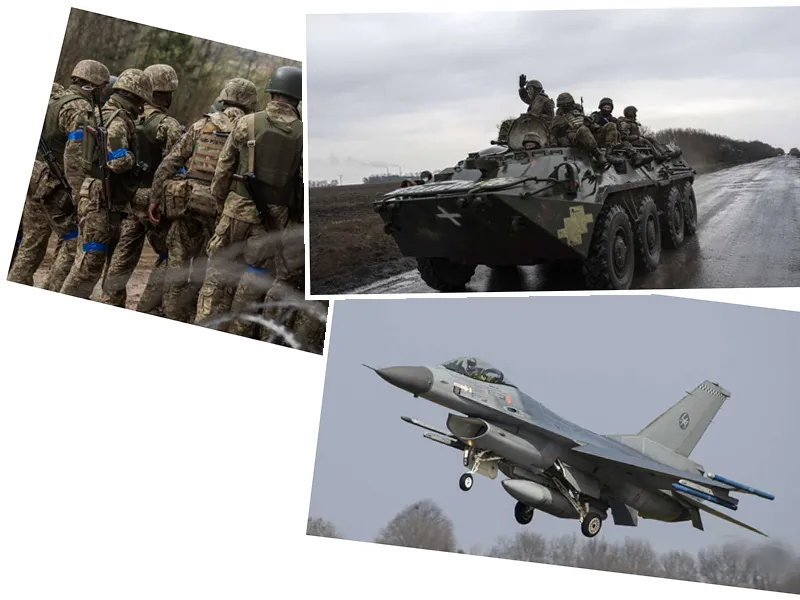Ukraine's F-16 Training Program Faces Scrutiny Amidst Growing Urgency
Far too little and far too late – the first twelve Ukrainian pilots should soon be able to take part in air combat. Politicians question the point. The deployment of Ukraine’s first batch of F-16 pilots, trained in the US and Europe, is facing skepticism over its effectiveness in countering Russian aggression. Over the past eight months, about twelve Ukrainian pilots have undergone training at Tucson Air Force Base in Arizona, completing a crucial step towards operating modern American-made fighter jets.
Despite the successful completion of this training phase, concerns loom large. US Defense Department spokesperson, Pat Ryder, had already warned about overly high hopes. According to Ryder, mastering these jets for effective combat could take years. Politico magazine views this as 'a decisive step', but doubts remain. Brigadier General Erin Hannigan from the Air National Guard refused to disclose the exact number of pilots trained or the completion date citing security reasons.
Reports from Air & Space Forces indicated preparation of eight more pilots early this year, while Newsweek added ten more trained at a British military flight school with subsequent training by the French Air Force. Ryder stressed that the goal was to support Ukraine in the long-term rather than contribute immediately to the ongoing counteroffensive.
James B. Hecker, commander of the US Air Forces in Europe, echoed similar concerns last October, estimating that the training process could extend up to five years before pilots become fully operational. This, according to Hecker, challenges the immediate impact of the fledgling Ukrainian pilots. Additionally, the Bundeswehr's standard training timeline of five to six years for mastering a Eurofighter underscores the complexity involved.
Michael A. Loh of the Air National Guard emphasized that the training program for Ukrainians was tailored but complex, reinforcing the long-term nature of Ukraine’s military strategy. As per his statement, the pilots are expected to complete their training by August 2024. This timeline makes political figures like Michael Turner and Jim Himes question the speedy scalability of the program.
In the broader context, high-level military and political leaders express doubts. With Russia deploying 300 fighter jets on Ukrainian territory, Ukrainian President Volodymyr Zelensky's urgent requests for 120 to 130 F-16s seem far from realization. Currently, Ukraine is set to receive 61 F-16s from Norway, Denmark, the Netherlands, and Belgium, but the timing remains uncertain, potentially offsetting any immediate strategic advantages.
Adding to training delays, the Bundeswehr requires five years to train a pilot fully. For experienced pilots transitioning to the F-16, training can take several months. The complex weapons systems and high-pressure learning environment present formidable challenges, as highlighted by former Bundeswehr pilot Joachim Vergin's seven-month transition from the Phantom to the Tornado fighter jet.
Military leaders, including Gabriel from the Bundeswehr, highlight differences between military and civil aviation, noting the accelerated pace of military training. Similarly, US lawmakers voiced skepticism in a letter to US Secretary of Defense Lloyd Austin, questioning the adequacy of a dozen semi-trained pilots in the broader context of Russian aerial dominance.
In a related development, French military instructors are set to arrive in Ukraine to further assist in training Ukrainian forces, as announced by General Oleksandre Syrsky. While the French Armed Forces Ministry remains non-committal on the details, the initiative underscores a continued commitment to enhancing Ukraine’s defensive capabilities.
French President Emmanuel Macron had previously discussed sending Western troops to aid Kyiv, highlighting the ongoing geopolitical tensions. Claims of French mercenaries aiding Ukraine have sparked controversy, although Paris has firmly denied having such forces on the ground. This nuanced international commitment underscores the complex geopolitical landscape faced by Ukraine amid its ongoing conflict with Russia.
- Preparing new pilots for complex fighter jets remains a significant logistical and strategic challenge. The tailored training program for the Ukrainian pilots, while highly specialized, also elongates the timeline necessary for these pilots to be deemed fully operational. Initiating this program underlines the deep-seated intricacies of modern aerial warfare and the significant time investment required.
- Moreover, the involvement of multiple countries such as the US, UK, and France in the training regimen highlights the broader international coalition efforts to bolster Ukraine's defensive and offensive capabilities. The scale of training and the complexity of integrating newly trained pilots into active combat scenarios are protracted endeavors with long-term implications.
- The geopolitical dynamics and differing training standards underscore the pressing need for a coordinated, efficient, and scalable approach to pilot training. The international community's commitment, from training Ukrainian pilots to pledging fighter jets, indicates a multifaceted strategy to address immediate and future threats posed by Russian aggression.
- While initial steps such as the arrival of French military instructors signify progress, systemic challenges remain. The slow trickle of trained pilots onto the battlefront against the backdrop of immediate demands lays bare the immense strategic difficulties Ukraine faces.
- Ensuring adequate training and adjusting to the ever-changing dynamics of the battlefield requires accelerated timelines, sophisticated coordination, and unwavering political support from allied nations. Enhancing operational readiness of Ukrainian pilots remains an intricate task that demands continuous evolution and responsiveness to Ukraine’s tactical needs.






